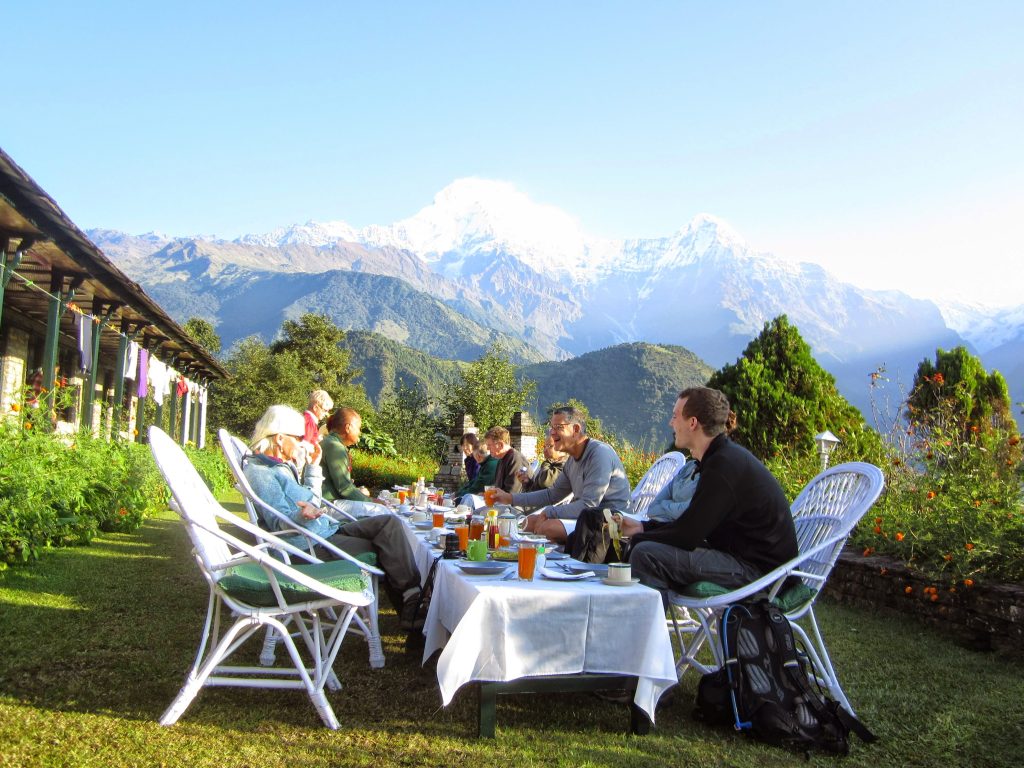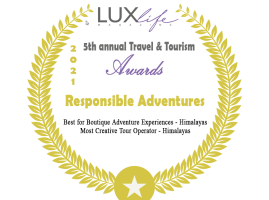Buddhist Mask Dances: Ritual Dance by Tibetan Monks
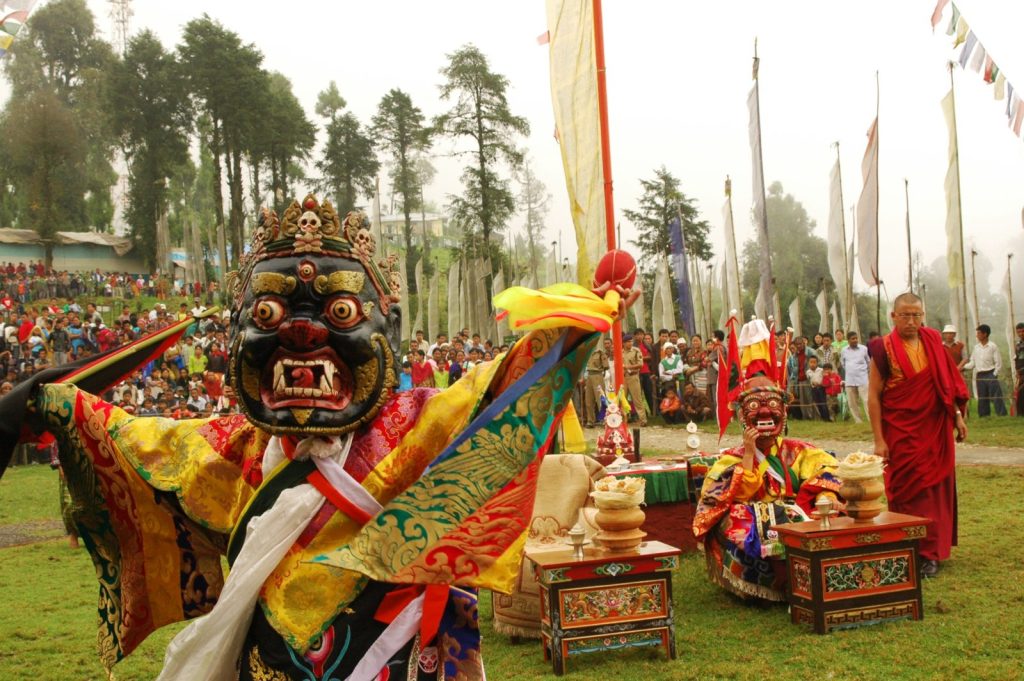
The vibrant Masked dances performed by Tibetan Buddhist monks are called “Cham” – Dance in Tibetan. It is presented in colourful costumes vibrantly with its roots in Tibetan Buddhism. The monks almost always perform mask dances. The dances depict tales of the destruction of evil spirits by the deities for humankind’s greater good. The ceremonial dance or Cham is practised all over the Himalayas, where Tibetan Buddhism has practised actively. The Himalayan regions of Tibet, Bhutan, India, and northern areas of Nepal are where these mask dances occur during unique festivals. The performance can be spellbinding to those attending the celebrations. Origin of Mask Cham (dance) The origins of the Tibetan Buddhist Mask Dance date back to around the 6th century; Ancient Indian literature tells of Ger’s sacred dance performed by the Dakinis when Kalachakra’s lesson. Cham is part of a Tantric ritual. Tantra was developed in ancient India, in the region of modern-day Pakistan. Many cham elements to their roots in Hinduism and the Bon tradition (Tibet’s spiritual practice before Buddhism). The Cham dance tradition depicts the tale of what Guru Padmasambhava did to eradicate evil spirits that obstructed Samye Monastery’s construction in the 8th century. The mask dances are an integral part of Mahayana Buddhism. The religious significance of Cham The Cham is considered an act of cleansing of the evil forces. The dance is performed in colourful brocade costumes and elaborate masks. The Gods and Deities of Tibetan Buddhism are summoned before the performance. The dance is influenced by tantric traditions and is done for the betterment of all sentient beings. The dance focuses on chanting, hand gestures, and the deities’ invocation while concentrating on negativity deletion. The performance acts as moral lessons for the laypeople while narrating stories of their legendary gods. It also familiarizes the laypeople with the kind of deities they will encounter during their 49 days of the transition period (called Bardo in Tibetan) between death and rebirth. It is performed at monastic courtyards around a central prayer flagpole. The performers hold conventional instruments in their hands and dance to the monastery’s musical instruments’ tune. The hand gestures represent different aspects of the tale. There is also some comic relief to lighten the sombre sequences when performers jump into the scene in skeleton costumes and other characters by performing acrobatic and comic feats. The Cham performance can last from 2 days to over 15 days, from the deities’ invocation to the commencement. Finally, a climactic scene is enacted when the ‘Chams’ approach its end. A sacrificial offering takes place by making a human figure from dough made from roasted barley. It is cut ritually into pieces and scattered in the four essential directions. It represents the eradication of Buddhism’s enemy and purifies the human soul from the three evils of ignorance, jealousy, and hatred. The mask dance gives an insight into the Buddhism’sh culture and heritage of Masks and Costumes. The Cham dance’s main attraction for many non-Tibetans is the multitude and diversity of the colourful masks. The Masks represent the embodiment of the wrathful deity. The Mask drives terror and great fear into the hearts of the evil forces. However, it also provides tranquillity and peace to Buddhists seeking enlightenment through prayer and meditation. Antique masks are considered very special and consequential. They are revered with pilgrims praying before them, especially on special occasions or during religious festivals. The famous stone mask of Palden Lhamo, located in the Jokhang Temple in Lhasa, is one such item. The Cham masks are about two to three times larger than a human head and substantial. The dancers wear padded caps or folded towels to cover their forehead, sides of the face, and neck to avoid chaffing and cuts because of the Mask’s weight, an awkward centre of gravity, and sharp-edged corners. The Cham performers wear brightly coloured robes, aprons, and ornaments traditionally made of bones. Antique costumes are rare due to time, rodents, insects, and wear and tear. However, along with a broader selection of modern accessories, the silk and brocade will soon make for a more extensive collection of modern colourful, flowing costumes to be reproduced. In addition, the old decorations made from animal or human bones can now be designed from various plastic or other material for easier acquisition and much faster work. The monks wear the costumes over their usual dress minus the outer clothing. The dance costume consists of a gown with long, broad sleeves over which a short triangular cape called a tippet can be worn. It is a poncho-like mantle that is either decorated or embroidered colourfully. Check out our Trekking packages for Nepal, Bhutan, India, and Tibet.
Trekking in Nepal during winter months of December, January and February
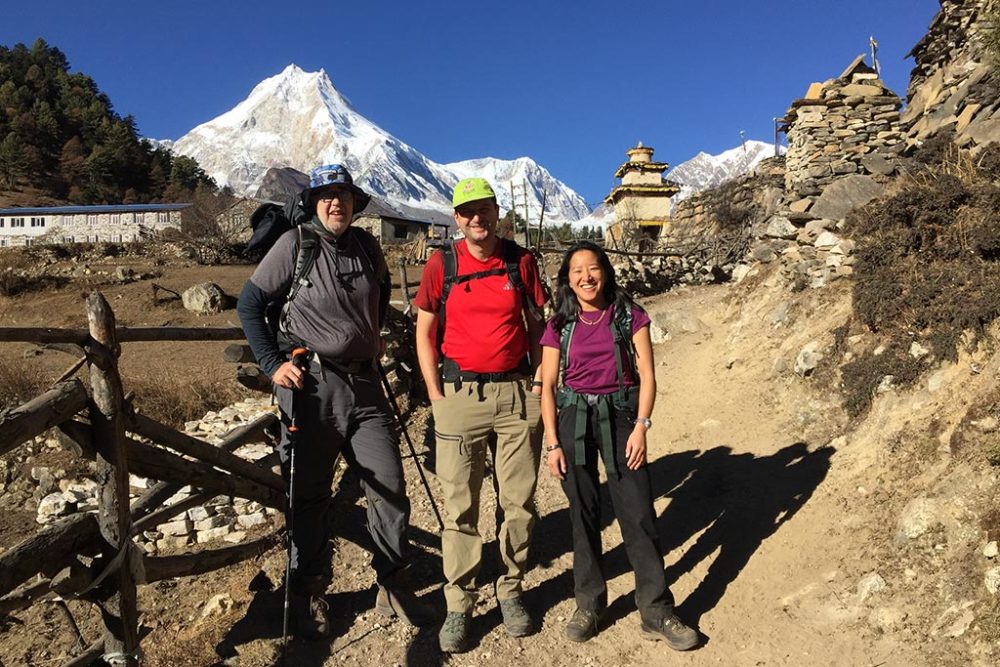
Most people are discouraged from going to the highest mountain chain in the world in the winter. They think trekking in the Himalayas is crazy, suspecting it to be cold. They couldn’t be more incorrect. Nepal lies at a similar latitude as Cairo and Miami, closer to the Equator than the Arctic Circle. So if you choose to trek in the middle hills with altitudes ranging from 1000 meters to 3500 meters, don’t be surprised if the temperatures are in the high teens or even low 20s degrees Celsius than the summer of some Northern European nations. However, it pays to invest in the right quality gear, such as a down jacket, a couple of fleece jackets, pants, base layers, warm hats, gloves, and sleeping bags, to name a few essential types of equipment. It is better to have more than less. One of the best-kept secrets is that trekking in Nepal during the winter has many benefits. Gone are the days when it used to snow by the end of November or early December due to climate change. It is good to dress up in layers, which you can ‘peel’ one at a time when you start to warm/heat up as you begin trekking. When we did our Annapurna circuit trek with Tilicho Lake in January 2018, we met both tourists and locals who misinformed some trekkers whole. For example, some locals told them that the higher villages and the Thorung pass were deeply covered in deep snow. The people who said these are likely to have done very little to no trekking experience. Benefits of Trekking in Nepal Himalaya during the winter. For the same reason mentioned above, most people think winters in Nepal are freezing; some might even imagine most of the country is covered in snow. This couldn’t be further from the truth. The colder weather keeps the clouds down longer, and even if the clouds form and rise in the afternoons, they sink quicker due to the cold than in the warmer months. This makes the visibility of the mountains clear for most of the day. The past two winters have been very clear like they used to be 20-25 years ago. There will be many fewer trekkers on the trail and lodges if you go trekking to the famous trekking areas where there are lodges. You will be warm while hiking in the sunny weather – perhaps even sweating on uphill climbs. You could be the only trekkers in the lodge. For the same reason, the wifi works better in the hostels as fewer people log in. You can use the internet better for weather forecasts and temperatures. There will be fewer people queuing for hot showers. Despite winter, don’t be surprised by the greenery or flowers in the lower altitudes. The open lodges in the higher altitudes are left to the employees during winter, while the owners go for warmer places such as Kathmandu, Pokhara, or Chitwan. The employees get to keep the profit from food sales; they only have to replace what was used. This is a way for the employees to supplement their low salaries. Can I do a high-altitude trek in Nepal during winter? You can undoubtedly do a high-altitude trek in Nepal during winter. The better time to do a high-altitude trek during winter is in December and January. We do receive some precipitation for a few days every month. We have begun to receive heavier snowfalls during February and March rather than in the middle of winter. Dangers/Inconveniences of trekking in Nepal during winter. Not all the lodges in the higher altitude will be open. Not all food on the menu will be available. The toilet floors might freeze from water/urine spillage in the higher altitude treks. If possible, try to find toilets inside the main building; better still, ask if they have a room with an attached bathroom. Again, minimize spillage in the bathroom to avoid icing. Toilets could be frozen/blocked due to the cold at higher altitudes. The paths through villages could be icy because the villagers have to let the public tap run all the time to prevent the pipe from breaking from freezing. The trail could be icy, and dirt can camouflage the ice. There could be very windy conditions in the higher elevations, be prepared. Despite mentioning less snowfall in December and January, you might encounter rainfall in the lower elevation or snow. After all, mountain weather can change without much warning. Update: Winter of 2018/2019 The Nepal Himalayas experienced good rain and snowfall in December, January, and February as they used to 20 years ago. We recently did a trek to Gokyo Lakes and Everest Base camp trek in December 2017 Before writing this blog, yours truly finished the Annapurna circuit trek with Tilicho Lake in January. We operated a trek to Langtang – Gosainkunda in December/January 2016-2017 We did a hike to Annapurna base camp in December/January 2014-2015 Check out our Trekking packages for Nepal, Bhutan, India, and Tibet.
What is better to bring to Nepal cash or ATM cards

What is better to bring to Nepal, cash or ATM cards Are you wondering how to exchange currency in Nepal, be relieved? You can easily exchange a wide variety of currencies in cities and towns frequented by tourists in Nepal. There are many money changers in Kathmandu, Pokhara, and Chitwan. You can also exchange your money in hotels and guesthouses; you won’t be getting the best rates, though. The most readily accepted currencies are US dollars and Euros. Travel companies, hotels, and airlines take these currencies in cash. If you need to exchange a significant amount, e.g., $500 or more, ask the moneychanger to give you a better rate. You can get a higher exchange rate than what is shown on their rate board. The accepted cards are Visa, Master Card, Maestro, Diners Card, Cirrus, and American Express. If you want to pay using your credit card, there is a service charge of 3.5%. Know our Money Nepal’s currency is called the Nepalese Rupees. Therefore, the shops, vendors, or service providers might use NRP, NRs, and Rs abbreviations to denote the local currency price. You can also ask your travel agent or hotel, and they can help you exchange your cash for Nepalese rupees according to the present exchange rate generated by Nepal Rastra Bank (Central Bank of Nepal). This is the easiest way to exchange currency in Nepal. If you are unsure if the currency you plan to bring is accepted, go to this Nepal Rastra Bank page. The best place to exchange money would be in Thamel’s tourist district, where many money changers exist. If you are going on a trek, it is best to have local currency with you and bring a little extra if you run out. You will get a lousy exchange rate in the villages, as the lodge owners must wait until they get down to a city/town before changing your foreign currency into local money. If you have leftover local currency, you can use it for food or shopping after your trek. It is always good to have small denominations to make small payments, especially trekking. If you have a significant amount of cash, ask your hotel reception for a safety deposit box; if there isn’t one in your room, do not leave unattended money in your room. ATMs There are some modern banking facilities in Nepal these days, and there are even branches of some international banks in Kathmandu and Pokhara. You can also use your credit/debit cards to withdraw money from the numerous Automated Teller Machines (ATMs) if you don’t like carrying a lot of cash. Some of you are fortunate that your bank back home reimburses you the fee local banks charge you for dispensing your money. Most ATMs in Nepal allow fast cash transactions of Rs.10,000 (slightly less than US$100) and charge you between Rs.200 – Rs.400, depending on the bank. Quite a few bank ATMs allow you to withdraw as much as Rs. 35,000 (roughly $350) at once, charging you a fee of Rs. 400. Sometimes, the machines might not be working. Still, as mentioned above, many ATMs in major cities accept International cards, dispatching cash in Nepalese rupees. There is a security guard outside the ATM lounge or machine. This doesn’t happen often, but it is better to use ATM outside its related bank just if the machine retains your card so you can retrieve it from the bank. Travellers’ Cheques and Credit cards Traveller’s cheques are no longer accepted in Nepal. As mentioned above, you can use your debit/credit card to make payments, but it is much easier with cash. Do inform your bank that you are travelling as some banks automatically stop transactions suspecting your card’s theft or fraudulent activities. More Travel Tips. Check out our Trekking packages for Nepal, Bhutan, India, and Tibet.
People Of Nepal Race And Ethnicity
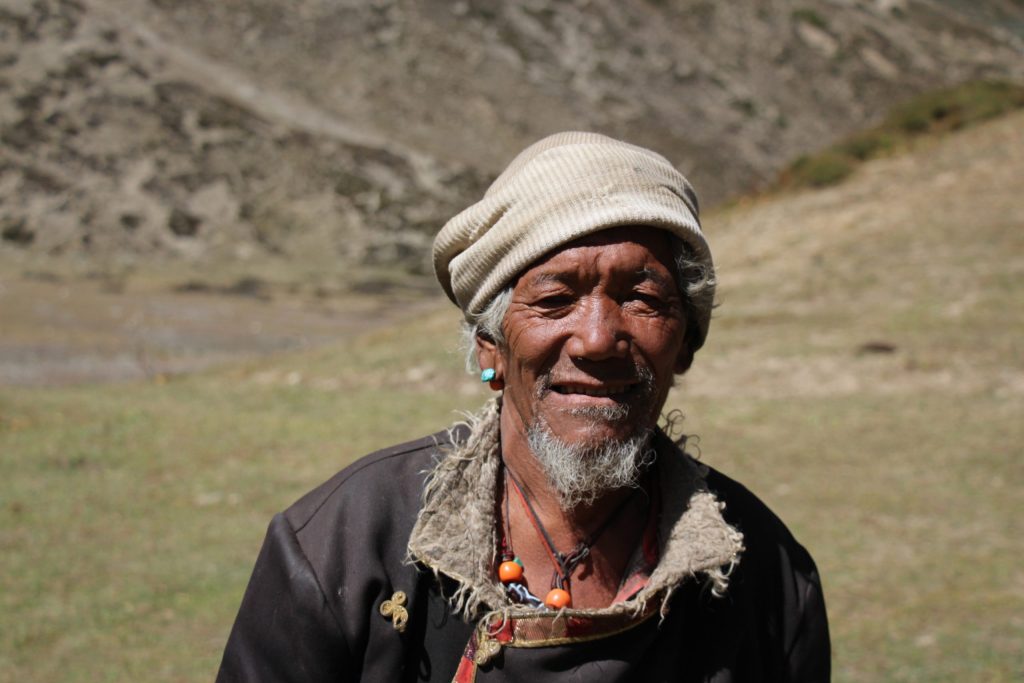
People of Nepal – Race and Ethnicity. This is a short article on the misuse/misconception of differentiating factors amongst our fellow Nepalese on Caste and Languages. I am not qualified as an expert, but these are my thoughts after spending nearly 30 years speaking to the elders of various communities in the country. It is not rocket science – after all, 1+1 always = 2 no matter what formulas are used. There are two primary races in Nepal. i) The Indo-Aryans or the Indo-Nepalese ii) The Tibeto Burmans or the Tibeto-Nepalese People of the Tibeto-Burman race came to Nepal in different periods from Mongolia and Tibet. The Kirats came from the East and Ruled Kathmandu sometime in the 7th or 8th centuries. The Tamangs and Gurungs came to fight with a ruler of a small kingdom in the Indian Subcontinent. While returning to Tibet, after their victory over the principality, some realized that the land here was more fertile with warmer weather and decided to settle in these hills, known as Nepal today. The Sherpas settled in Nepal between 600-700 years ago, and other ethnic groups’ migration has continued over the centuries. Although the Indo-Nepalese migrants were latecomers to Nepal compared to the migrants from the north, they have come to dominate the country not just in numbers but also in society, politics, and the economy. They achieved early dominance over the native and the northern migrant populations, primarily because of the superior formal educational system they brought with them. Their domination has had tremendous significance regarding ethnic, bureaucratic, and political power structures. In the first two groups, the direction of their migration and Nepal’s landscapes appeared to have led to their vertical distribution; most ethnic groups were found at particular altitudes. The first group, Indo-Nepalese origin, inhabited the more fertile lower hills, river valleys, and Tarai plains. The second dominant group consisted of Tibeto-Mongol origin communities, occupying the higher elevations from the east to the west. Finally, the third and much smaller group comprised some tribal communities, such as the Tharus and the Dhimals of the Tarai; they may be remnants of indigenous communities whose habitation predates the advent of Indo-Nepalese and Tibeto-Mongol elements. When you arrive in Nepal, you might hear someone introduce her or himself to you in this manner: 1) “Hello, My name is Chudamani Adhikari. Chudamani is my name, and Adhikari is my caste”. 2) “Hi, John, nice to meet you. My name is Indra Hang Limbu, and I am from the Limbu caste. 1) Chudamani is half-correct, as Adhikari is one of the many clans within the Brahmin Caste. 2) Indra is incorrect, saying his Caste is Limbu. Limbu is an ethnic group that has its clans and sub-clans. For the Hindus, their last names reveal the Caste they belong to. As the Indo-Nepalese were the pioneer educators, they taught the Tibeto-Nepalese that their surname and Caste are the same, hence the misconception. As mentioned above, the Hindus have a caste revealed by their last name. In the case of the Tibeto-Nepalese, their last names show either their Ethnic group and clan or sub-clan. For example, The Rai ethnic group has different clans and sub-clans. They also have a staggering 14 dialects within their ethnic group. This is the most dialect within a single ethnic group. In 2011, The Nepalese government mentioned that there are 123 mother tongues/languages. The Tibeto-Nepalese speaks most of the dialects. I believe they are variant Dialects of the Tibeto-Burman language. Marriages. Most people in Nepal used to marry within their castes and ethnic groups. When the marriage occurs between two different castes of the Indo-Aryan race- it is called an intercaste marriage. It is also called intercaste marriage, when persons of two different ethnic groups get married. Technically it is a marriage within the Tibeto Burma race but between two other ethnic groups. A marriage between an Indo-Aryan and a Tibeto Bruman is also called intercaste; in reality, it should be called interracial marriage. For Details on Caste Read about The Sherpas Check out our Trekking packages for Nepal, Bhutan, India, and Tibet.
Who Are The Sherpas And What Do They Do

Who are the Sherpas, and what do they do? If you have read books about early exploration in the Himalayas during the early 20th century to the mountaineering expeditions until recently, you would most likely have read, “My Sherpa carried this much, or this Sherpa could do this unbelievable feat in such height altitude with a load like that” etc. I have heard trekkers say many times, “How many Sherpas will accompany us or meet my incredible Sherpa or my Amazing Sherpa guide.” Let me clear this up for you. Reading early books of explorers in the Himalayas has made you believe that a Sherpa is a porter, especially at high altitudes, or all porters are Sherpas – not true. A brief history of the Sherpas – Who they are. First, the Tibetan words derive from Shar (east) and Pa (people) – People of the east. Some oratory history has it that they originated in the Kham region of Eastern Tibet. They moved west searching for grazing pastures for their animals and traded 600 -700 years ago. In the past days, there were no borders on the higher grounds below the mighty Himalayan peaks. They crossed over Nangpa La pass into the Solu Khumbu district of Nepal and settled in a gentler climate with fertile land. Solukhumbu is also home to Mount Everest and Sagarmatha National Park. The Khumbu valley, which lies in Mount Everest’s shadow, is home to hundreds of Sherpa families. Another version is that they moved into Solukhumbu, permanently fearing religious persecution. Most of them are Buddhists, although a growing number are now Christians. Their language is related to other Tibeto Burman languages spoken in Nepal, Myanmar, India, China, and elsewhere. Like most high Himalayas inhabitants, The Sherpas only had two names – the day they were born was their first name and a given name, e.g., Mingma Tsering, but today it will be Mingma Tsering Sherpa. They added the name Sherpa because the Hindus of Nepal required a surname for official documents/work, so to adapt to the requirement, they included Sherpa as their surname, and they are renowned the world over with that last name. Their role in tourism. The Sherpa people’s economy and culture changed dramatically in the early 1900s when the British survey and mountaineering expeditions made Mount Everest the ultimate destination for climbing. This was the beginning of the modern era of significant mountaineering tourism. In the past, it was sacrilegious to climb mountains as The Sherpas and Hindus believed the mountains were where the Gods lived. In the 1950s, Nepal opened its doors to the outside world, coinciding with mountaineers’ mad rush to see who could bag the first 8000-meter summit. This rush exposed the Sherpas’ prowess in the high-altitude world. They have set and broken several mountaineering records over the decades. They are the real Super Heroes of the Himalayas. They have set and broken records and are listed in The Guinness book of records; some have won National Geography’s Adventurers of the year awards. Here are a few names : Pasang Lhamu Sherpa became the first Nepalese woman to climb Everest. Updated 29/6/2018 Ngima Nuru became the first person below 40 to reach the summit of Everest 21 times. It seems he will be setting new Everest Summits for many years to come. Kami Rita Sherpa reached the summit of Everest a record 22 times. He has reached the summit of Everest 25 times in 2021. Lhakpa Sherpa broke her record a year ago to reach the Everest summit nine times, making her the women’s world record holder. Apa Sherpa is the first to have climbed Everest 21 times – a fellow Sherpa has broken this record. Phurba Tashi Sherpa has been featured on Discovery Channels’ Everest – Beyond the limit and, more recently, on Sherpa – The Movie. He is also the record holder of 34 summits of mountains above 8000 meters. They have set and broken many speeds ascend Everest records in less than 10 hours. Nima Jangbu Sherpa became the first woman to climb Lhotse, Everest, and Kanchenjunga within 25 days. She is also the first Nepali woman to summit Kanchenjunga. Pemba Gyelje Sherpa, Lhakpa Tseri Sherpa, and Pasang Lhamu Sherpa Akita have won Nat Geo’s Adventurer of the year awards. In the 1960s, commercial trekking was introduced in Nepal. Now Sherpa became a designation – an assistant guide who would walk with the clients, set up tents, serve the meals, help weak trekkers or even carry a sick or injured trekker to safety. Later on, anyone who did this job was called a Sherpa despite being from any other ethnic group. The late 1980s and early 1990s saw a further change in their roles in tourism. Some started their trekking and mountaineering companies, while others on the main trail to Everest base camp and adjacent valleys built “tea-houses” to serve the early backpackers. Now the teahouses have been transformed into beautiful lodges, with some having en-suite bathrooms and even electric blankets! With the income from being tourism entrepreneurs, the older Sherpas have realized the importance of education. As a result, today, there are very successful Sherpas in all professions from being Doctors, Engineers, Pilots (flying both in Nepal and International airlines), contractors, owners of airlines, helicopter companies, own luxury hotel chains in the mountains, and are in other businesses to name a few trades they have adapted to now. There is still considerable pride amongst the Sherpas, who support mountaineering expeditions as guides. They believe they make US$4000-US$6000 from 2-month work plus bonuses from grateful clients. This amount is nearly double what people in a city like Kathmandu need to sustain a small family in a year. But, of course, the Sherpas and their families know how dangerous mountaineering is; a considerable number of families have resettled overseas, especially in the U.S.A. As a result, the highest number of Sherpas outside Nepal can be found in the U.S.A. Check out our Trekking packages for Nepal, Bhutan, India,
Manaslu Circuit Trek Report Post Earthquake

The Manaslu circuit trekking route was severely affected by the massive earthquake of April 2015. The epicentre of that devastating earthquake was in Gorkha District, where Mount Manaslu – the world’s 8th highest mountain is located. So you must be wondering and asking the question, can I still do Manaslu Circuit trekking after the earthquake? We decided to do the trek ourselves and write a first-hand report on the trail condition. We did this trek from 4th – 17th December 2016. We were blessed with perfect weather during the trek, where the views were clear throughout. We found that most of the damage on the villages and trails were either repaired or rebuilt. In addition, the Nepal government has installed new bridges and walkways. However, in certain parts of the path where landslides occurred during the earthquake, we noticed huge boulders coming down the trail and onto the Buri Gandaki River. Road construction is going on to reach Larke La pass to connect with the Manang district. However, the construction of roads requires blasting off part of the hills, removing huge boulders, destabilising the mountain, and making it susceptible to landslides for several years. During late September, at the tail end of the monsoon, a group of trekkers and their support crew were caught in a landslide when three Nepali crew members, including the company owner, a guide, and a trekker, were killed; just a few minutes walk away from Tatopani (hot springs). This landslide had settled when we crossed it, but it could get active when it rains or the next monsoon. Landslides usually take a couple of years or more to settle ultimately. We observed a new menace was the increased number of mules plying on the trail. Despite December being off-season, the mules were used to resupply the lodges for the coming spring season. The paths are narrow, with some harrowing drops into the Buri Gandaki River. Additionally, some of the mule drivers make the mules trot while returning to the road head at Soti Khola, which can be menacing to the trekkers on the narrow trails. It is best to listen to the bells’ sounds of approaching mule caravans as a warning – so it is best not to listen to music with earphones while trekking. There are close to 2000 mules used to carry supplies to the villages along the Manaslu Circuit and Tsum Valley. We saw a new and dangerous landslide on our hike to Gap with no warning. There was a potential of falling into the raging Buri Gandaki River a couple of hundred meters below. Our porters who got to this landslide managed to get past this landslide with much difficulty. Every few steps they took forward, they slid a few steps back. Had it not been for their steady foot, there could have been some injuries or worse. While we were in Samdo, the lodge owner’s husband drives mules to supply the villages and called to inform his wife that a fresh dry landslide had cut off the trail. Unfortunately, this landslide took place close to Lapu Besi, where we had lunch on day 1 of our trek. Hence his arrival was delayed until the path was reopened. On the last day of our trek, we started from the village of Gowa. After a short walk past the village, we came upon a detour; we checked out what seemed like an alternative route to find that it went next to the raging Dudh River. We retraced our steps and passed the blocked trail to find ourselves in another landslide. Having negotiated our way across initially, we had to scramble back up to make it to a ridge we had not been able to see previously – a new road that had been constructed. It was quite a nerve-wracking experience until we reached more solid ground. There should have been a clear sign directing trekkers to the newly built road, or the lodge owners could have informed us of this matter. I hope the concerned authorities or departments will immediately rebuild the trail and signs and provide proper maintenance. Anyway, all is well that ends well. Text: Raj Tamang Photo Courtesy: Tara Austin Check out our Trekking packages for Nepal, Bhutan, India, and Tibet.
The Best Time To Trek In The Himalayas
